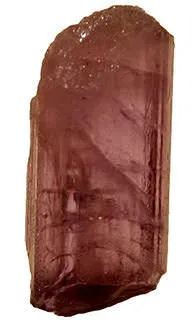 Gem quality scapolite was first found in Myanmar in 1913. The name scapolite derives from a combination of the two Greek words scapos, meaning rod, and lithos, meaning stone. Scapolite crystals are found as prisms that resemble sticks, which is why their name refers scapos. Scapolite is also sometimes called wernerite after the German geologist A. G. Werner (1749-1817). The best, and most valuable scapolite stones are prized for their color, particularly when they are yellow to orange or pink to violet. Scapolite is rarely found in sizes over 15 carats. Only a few gems larger than this have been found. When cut as cabochons, scapolite usually exhibits a cat's eye effect, but because the stones splinter easily, they are difficult to fashion.
Gem quality scapolite was first found in Myanmar in 1913. The name scapolite derives from a combination of the two Greek words scapos, meaning rod, and lithos, meaning stone. Scapolite crystals are found as prisms that resemble sticks, which is why their name refers scapos. Scapolite is also sometimes called wernerite after the German geologist A. G. Werner (1749-1817). The best, and most valuable scapolite stones are prized for their color, particularly when they are yellow to orange or pink to violet. Scapolite is rarely found in sizes over 15 carats. Only a few gems larger than this have been found. When cut as cabochons, scapolite usually exhibits a cat's eye effect, but because the stones splinter easily, they are difficult to fashion.
 Scapolite is a transparent stone, occurring in a wide range of colors from colorless to white, pink, purple, violet, violet blue, blue, yellow, red, orange, gray, and greenish to bluish gray. The difference in color reflects variations in the stones' composition, ranging from sodium-rich to calcium rich. Orange, light red, and whitish colored varieties may also occur as semi-transparent stones. The most likely colored stones to appear in jewelry are the violets and yellows, and possibly the orange cats eyes. These can be easily be mistaken for yellow
Scapolite is a transparent stone, occurring in a wide range of colors from colorless to white, pink, purple, violet, violet blue, blue, yellow, red, orange, gray, and greenish to bluish gray. The difference in color reflects variations in the stones' composition, ranging from sodium-rich to calcium rich. Orange, light red, and whitish colored varieties may also occur as semi-transparent stones. The most likely colored stones to appear in jewelry are the violets and yellows, and possibly the orange cats eyes. These can be easily be mistaken for yellow ![]() beryl, amblygonite, chrysoberyl, golden beryl, or certain
beryl, amblygonite, chrysoberyl, golden beryl, or certain ![]() quartz minerals like
quartz minerals like ![]() amethyst or citrine. Scapolite only rates a 6 on the hardness scale. The stones are seldom cut as they have three directions of easy cleavage, which makes them difficult to work with. Stones must be treated with care, and are not really suitable for use in rings.
amethyst or citrine. Scapolite only rates a 6 on the hardness scale. The stones are seldom cut as they have three directions of easy cleavage, which makes them difficult to work with. Stones must be treated with care, and are not really suitable for use in rings.
 Scapolite stones are also distinctly pleochroic. Scapolite has been said to be an important stone for our future as it represents inner peace though faithfulness to ourselves. Wearing the stone helps us see what is truly important, and helps us embark on our true path. It is a stone that helps us tackle whatever responsibilities we may be trying to avoid, therefore pushing us onto the paths we are meant to walk. Scapolite is commonly found as prismatic crystals in pegmatites and metamorphic rocks, like mica schist and gneiss. It occurs particularly in metamorphosed limestone. Scapolite also occurs in massive form. The gemstone was first discovered in Myanmar, but was then rediscovered in Brazil and also recently in Kenya.
Scapolite stones are also distinctly pleochroic. Scapolite has been said to be an important stone for our future as it represents inner peace though faithfulness to ourselves. Wearing the stone helps us see what is truly important, and helps us embark on our true path. It is a stone that helps us tackle whatever responsibilities we may be trying to avoid, therefore pushing us onto the paths we are meant to walk. Scapolite is commonly found as prismatic crystals in pegmatites and metamorphic rocks, like mica schist and gneiss. It occurs particularly in metamorphosed limestone. Scapolite also occurs in massive form. The gemstone was first discovered in Myanmar, but was then rediscovered in Brazil and also recently in Kenya.
 Scapolite is a collector's item with the roots of its family tree found in many different countries all over the world. Transparent yellow varieties of the stone have been found in Myanmar, Madagascar and Brazil. Brazil also has been known to provide colorless and white varieties. Madagascar, Namibia and Tanzania have mainly yellow stones. Myanmar, because of its soil, produces purely colorless versions, as well as different shades of yellow, rose-red and blue. In Sri Lanka, the colors range from colorless, to rose-red, gray and even black. For a long time the beautiful rose-red variety was only found in Myanmar, but then Sri Lanka unexpectantly followed in 1982, and for a few years, Pakistan has also been supplying the market. Today, the best quality scapolite gemstones come from the Umba River area, northeast of Tanzania. Scapolite can also be found in various locations around Australia, Africa, Mexico, Norway, Sweden, Tajikistan, the United States, and Canada.
Scapolite is a collector's item with the roots of its family tree found in many different countries all over the world. Transparent yellow varieties of the stone have been found in Myanmar, Madagascar and Brazil. Brazil also has been known to provide colorless and white varieties. Madagascar, Namibia and Tanzania have mainly yellow stones. Myanmar, because of its soil, produces purely colorless versions, as well as different shades of yellow, rose-red and blue. In Sri Lanka, the colors range from colorless, to rose-red, gray and even black. For a long time the beautiful rose-red variety was only found in Myanmar, but then Sri Lanka unexpectantly followed in 1982, and for a few years, Pakistan has also been supplying the market. Today, the best quality scapolite gemstones come from the Umba River area, northeast of Tanzania. Scapolite can also be found in various locations around Australia, Africa, Mexico, Norway, Sweden, Tajikistan, the United States, and Canada.